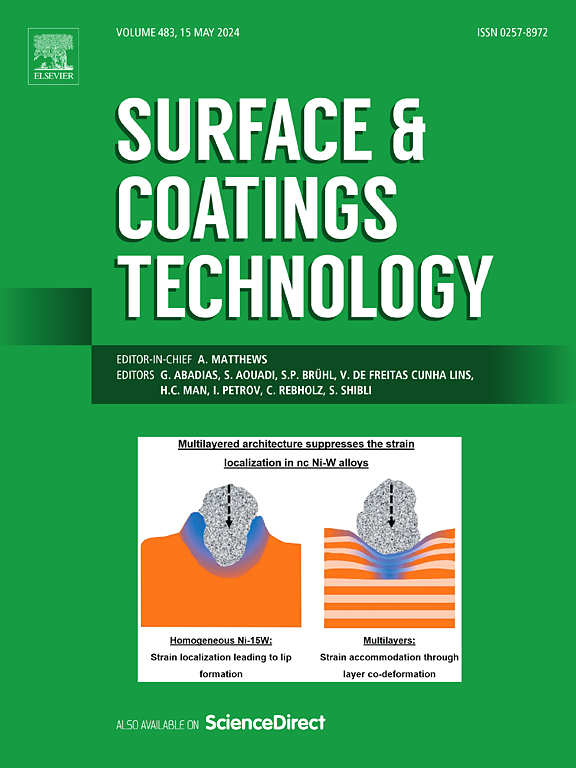Optimized ZrO2-based thermal barrier coatings via solution precursor plasma spraying with enhanced phase stability
IF 6.1
2区 材料科学
Q1 MATERIALS SCIENCE, COATINGS & FILMS
引用次数: 0
Abstract
Thermal barrier coatings (TBCs) for aero-engines require enhanced phase stability and thermophysical properties at temperatures exceeding 1473 K. This study optimized solution precursor plasma spraying (SPPS) to develop TBCs based on 8 wt% yttria-stabilized zirconia (8YSZ) and dual rare-earth co-doped ZrO2 (YGSZ and YYSZ). A Taguchi design was employed to determine optimal parameters: a precursor concentration of 2.35 mol/L, a hydrogen flow rate of 12 standard liters per minute (slpm), and a feed rate of 28 mL/min. These conditions produced coatings with 23 % porosity and a high proportion of dense regions. At 1400 °C, the Yb-Y co-doped ZrO2 (YYSZ) coating exhibited superior sintering resistance and phase stability, retaining structural integrity for 200 h with monoclinic phase formation limited to 35 %, compared to 42 % for YGSZ. The YYSZ coating achieved a thermal conductivity of 1.38–1.61 W·m−1·K−1, representing a 60 % reduction relative to conventional 8YSZ, with a thermal expansion inflection temperature of 580 °C. These improvements highlight YYSZ as a promising candidate for ultrahigh-temperature TBCs, addressing key challenges in next-generation gas turbines.
通过溶液前驱体等离子喷涂优化zro2基热障涂层,增强了相稳定性
用于航空发动机的热障涂层(tbc)需要在超过1473 K的温度下增强相稳定性和热物理性能。本研究优化了溶液前驱体等离子喷涂技术(SPPS),制备了基于8wt %钇稳定氧化锆(8YSZ)和双稀土共掺杂ZrO2 (YGSZ和YYSZ)的tbc。采用田口设计确定最佳工艺参数:前体浓度为2.35 mol/L,氢气流速为12标准升/分钟(slpm),进料速率为28 mL/min。在这些条件下,涂层的孔隙率为23%,致密区比例很高。在1400℃时,Yb-Y共掺杂ZrO2 (YYSZ)涂层表现出优异的抗烧结性能和相稳定性,在200 h内保持结构完整性,单斜相形成限制在35%,而YGSZ的单斜相形成限制在42%。YYSZ涂层的导热系数为1.38 ~ 1.61 W·m−1·K−1,比传统的8YSZ涂层降低了60%,热膨胀弯曲温度为580℃。这些改进突出了YYSZ作为超高温tbc的有前途的候选者,解决了下一代燃气轮机的关键挑战。
本文章由计算机程序翻译,如有差异,请以英文原文为准。
求助全文
约1分钟内获得全文
求助全文
来源期刊

Surface & Coatings Technology
工程技术-材料科学:膜
CiteScore
10.00
自引率
11.10%
发文量
921
审稿时长
19 days
期刊介绍:
Surface and Coatings Technology is an international archival journal publishing scientific papers on significant developments in surface and interface engineering to modify and improve the surface properties of materials for protection in demanding contact conditions or aggressive environments, or for enhanced functional performance. Contributions range from original scientific articles concerned with fundamental and applied aspects of research or direct applications of metallic, inorganic, organic and composite coatings, to invited reviews of current technology in specific areas. Papers submitted to this journal are expected to be in line with the following aspects in processes, and properties/performance:
A. Processes: Physical and chemical vapour deposition techniques, thermal and plasma spraying, surface modification by directed energy techniques such as ion, electron and laser beams, thermo-chemical treatment, wet chemical and electrochemical processes such as plating, sol-gel coating, anodization, plasma electrolytic oxidation, etc., but excluding painting.
B. Properties/performance: friction performance, wear resistance (e.g., abrasion, erosion, fretting, etc), corrosion and oxidation resistance, thermal protection, diffusion resistance, hydrophilicity/hydrophobicity, and properties relevant to smart materials behaviour and enhanced multifunctional performance for environmental, energy and medical applications, but excluding device aspects.
 求助内容:
求助内容: 应助结果提醒方式:
应助结果提醒方式:


